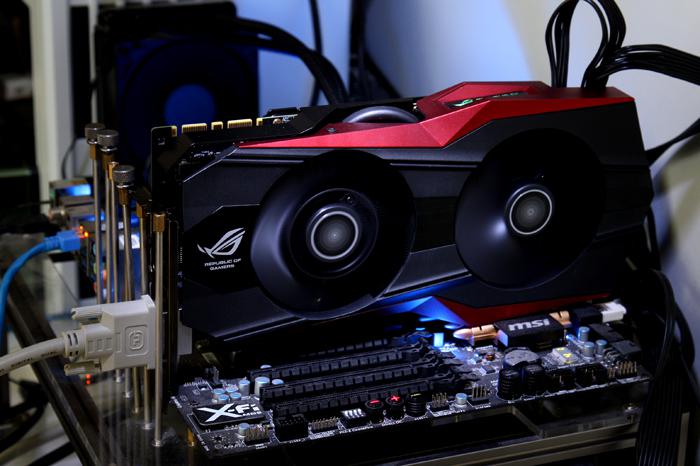Conclusion
Conclusion
ASUS has an impressive card at hand with the Matrix edition. Truth be told here though, if you stick to the standard cooler (air cooling), the benefits might not outweigh the price premium. I mean, temps, noise and overclocking wise a GTX 980 Strix will get you precisely the same, albeit the factory overclock on the Matrix is a tiny notch higher.
Obviously the game rendering performance is pretty sweet, the build quality top notch and the DirectCU II based cooling offers a very silent product, and heck it can overclock pretty nice as well reaching the 1500 MHz region on the dynamic boost clock. Design wise we thing this is a premium card, it looks great and the PCB with all its components just looks breathtaking. Nice to see is the included backplate and the black powder coating on the heat-pipes.
Maxwell GM 204 GPU experience overall
The GeForce GTX 980 leaves a very solid impression. Great performance within its range. It’s not heaps faster than a GTX 780 series though. So I do not expect GeForce 780 range product owners to upgrade anytime soon. However, if you are in say the GeForce GTX 680 range, then this might be a very nice time to jump on-board with a new card. It is interesting to see that 10 years ago performance per generation nearly doubled. With current release schedules we continuously see 20 to 30% performance increases across the board over the last-gen products. That is still respectable as you need to keep in mind that the GM204 is still on 28nm much like Kepler. Injecting more transistors onto a GPU creates yield issues, heat and high power consumption. The GK110 (GTX Titan / Black), whilst being a true beast of a GPU, is testimony to that. With that in mind Nvidia tried to create a product series that is affordable and plays the most high-end and latest games perfectly fine at an acceptable price level. When you look at it from that point of view the Maxwell release is a successful one. This is probably the maximum that Nvidia should and can do on 28nm in terms of improved performance and power consumption versus price.
Thermals
The reference design of the GTX 970 and 980 are the very same cooling wise. The reference products are set at an offset threshold of 80 degrees C. Once the GPU gets warmer the card will clock down and lower its voltage. ASUS improved on that reference design, you can expect the temperature to hover towards give or take 65 Degrees C with hefty games. Remember, that is factory overclocked cooling performance for you. So ASUS shaved off a good 15~20 Degrees C over reference. The cooler looks sturdy and bloke like as well, aesthetically it is a product that is easy on the eyes and will fit any dark and preferably red themed gaming PC quite well.
Cooling versus noise levels
The Matrix Platinum edition cools properly and is a reasonably silent product. Expect sound pressure values in the 40 to 41 dBA range at max under load and warm circumstances. That's measured 75 CM away from the PC. At best you can slightly hear some airflow the card while using them heavily.
Performance
A nice advantage for the cards is that they now come standard with 4 GB of DDR5 graphics memory (fully usable on the GTX 980), this means gaming sweetness in even the highest resolutions. All games play perfectly at up-to WHQD at 2560x1440. The GeForce GTX 980 is a nice card that certainly offers a nice chunk of performance in that high resolutions, albeit it will fall short here and there if you are at Ultra HD. Overall you can play all the modern and latest games with nice AA levels and excellent image quality, the PC gaming way. GeForce GTX 980 I would recommend with Ultra HD if you can tick off AA, however with upcoming MFAA (pending a driver release) you'll be able to play games quite well with this MSAA equivalent quality AA feature as well. It is a perfect card for gaming up-to 2560x1440.
Tweaking
Without extra voltage tweaking you can expect a ~1450 MHz range for the Turbo clock frequency. Depending on how much your board will take and allow, with voltage tweaking you’ll pass the 1450 MHz range. Roughly 1500 MHz on our end works with air-cooling, but it might depend per production batch and also variables like your PC stability, power supply and so on. We ended up at a stable 1517 MHz, which is a good clock frequency. But again, our overclock is not a guarantee for your results and if you reverse that, your tweaking results could also be better than ours. The memory is clocked standard at 7.0 GHz, you'll fairly easily achieve 7.5 GHz and we even reached 8.0 GHz stable. My advice is to keep your effective memory data-rate just under 8 GHz for a little more stability. Overall you’ll see a nice gain in extra gaming performance.
Final Words
If fancy is your thing then the Matrix Platinum edition is gonna be your #1 choice. However we do like to recommend you to look at the Strix if you plan to stick to air-cooling, as that product is much cheaper and will offer pretty a similar experience in all its ways. The reality is that the price difference is about a 100 EURO/USD. The Matrix Platinum does come with premium features intended for LN2 overclockers, a lot of space on the PCB, 14 power phases, an ASUS-exclusive "defroster" circuit, which is a trace running through key areas of the card which heats up, preventing frost and damp condensation on the card. The card has been factory tweaked for you, enough to make a difference. Overall in tweaking matter we pushed the card towards 1.5 GHz on the boost frequency, which was a shy bit lower than some of the competition, but certainly worthy of being called a grand overclock still. You guys will probably want to stick at 1450 MHz anyway on long term tweaking. Next to all that the card still remains very silent and at cool temperature levels. The product comes with all the features you'd want, from connectivity for your monitor to the performance cooler, from low noise levels to a nice factory overclock and the sheer aesthetics. A nice plus is the lower power consumption, though that alone would obviously not justify an upgrade from the 780 series, but is testimony to less heat and this results in better clock frequencies and higher overclocking results.
Concluding, the ASUS GeForce GTX 980 ROG Matrix Platinum edition is a great product, really great actually. But was designed for the pro-overclockers with sub-zero cooling in mind. The model as tested today hovers at roughly 650~700 EURO at the moment of writing, and that price makes this a tough sell really. We'll give the card a Top Pick award mainly for the intense and professional design, value wise you would be better off with the Strix, and that is the honest truth.
Related articles
- Nvidia GeForce GTX 970 and 980 reference review
- MSI GeForce GTX 970 Gaming OC review
- Gigabyte GeForce GTX 970 G1 Gaming review
- Gigabyte GeForce GTX 980 G1 Gaming review
- ASUS GeForce GTX 970 Strix review
- Palit GeForce GTX 970 Jetstream review
- GeForce GTX 970 SLI review
- GeForce GTX 980 2 and 3-way SLI review
Recommended Downloads
Sign up to receive a notice when we publish a new article
Or go back to Guru3D's front page


